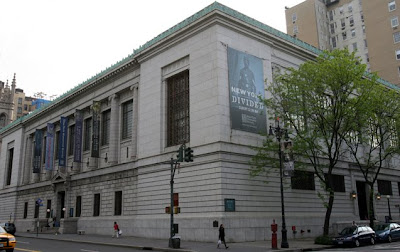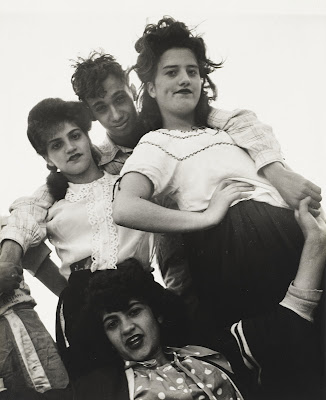 The New-York Historical Society will re-open its landmark building to the public at 11:00 a.m. on Veterans’ Day, Friday, November 11, 2011. A three-year, $65 million renovation of the Central Park West building has sensitively but thoroughly transformed the face of the institution — the first museum established in New York.
The New-York Historical Society will re-open its landmark building to the public at 11:00 a.m. on Veterans’ Day, Friday, November 11, 2011. A three-year, $65 million renovation of the Central Park West building has sensitively but thoroughly transformed the face of the institution — the first museum established in New York.
The Historical Society will remain open on November 11 until 11:00 p.m., offering free admission during that day to veterans and active service members and to children under 13, and free admission for all visitors after 6:00 p.m.
Entering the Historical Society, renovated by the firm of Platt Byard Dovell White Architects, visitors will encounter:
* an admissions area incorporating the ceiling from Keith Haring’s original “Pop Shop,” donated to the Historical Society by the Keith Haring Foundation
* a multi-media installation in the reconfigured Great Hall where the new Robert H. and Clarice Smith New York Gallery of American History introduces major themes of American history through stories and figures from New York’s past- to include a selection of objects from the Historical Society’s collection
* a new facility, the DiMenna Children’s History Museum and the Barbara K. Lipman Children’s History Library, designed especially to engage young visitors as History Detectives exploring the richness and wonder of America’s past
* the first major special history exhibition in the renovated building, Revolution! The Atlantic World Reborn, an exploration of the interconnections among the American, French and Haitian revolutions
* an art exhibition drawn from works in the Historical Society’s collection: Making American Taste: Narrative Art for a New Democracy offers for the first time an in-depth look at the 19th-century paintings and sculpture collected by the New Yorkers who founded and built the Historical Society
* an Italian-themed dining facility operated by the Starr Restaurants group, offering a light menu throughout the day and full restaurant service at night
“I believe 11-11-11 – November 11th, 2011 – will be marked as the most important date for our Society since its founding 207 years ago,” stated Roger Hertog, Chairman of the Board of the New-York Historical Society in a prepared statement to the press.
“The world has long known that the New-York Historical Society holds unmatched collections in its museum and library,” stated Louise Mirrer, President and CEO. “More recently, people have also begun to know us for our vibrant special exhibitions, which bring complex historical themes to life. But we have never before opened ourselves up to the public with such light and transparency, or provided the kind of immediate access to our objects and ideas that we will offer when we re-open in November. It’s as if, at entry level, we are going from being a beautiful treasure house to a great showplace of the American experience.’”
Renovating a Landmark
On the exterior, the renovation project creates a wider main staircase and expanded main entrance on Central Park West- better sightlines into the building from the street- a redesigned 77th Street entrance with improved accessibility for school groups and visitors with disabilities, and illumination to highlight the architectural features at night.
Inside the building, the project creates the Historical Society’s first new gallery on the ground floor, the 3,400-square-foot Great Hall- renovates and improves the adjacent Robert H. Smith Auditorium- provides for the new restaurant, renovated Museum Store and Rotunda on the 77th Street side- and establishes the DiMenna Children’s History Museum and the Barbara K. Lipman Children’s History Library, designed separately by Lee H. Skolnick Architecture + Design Partnership.
The building was designed and constructed in 1903-08 by York and Sawyer, a firm established by architects who had trained with McKim, Mead and White. York and Sawyer was also responsible for projects including the Federal Reserve Bank of New York, Bowery Savings Bank, New York Athletic Club and several of the buildings at Vassar College. In 1938, two new wings were completed at the Historical Society, designed by Walker and Gillette. The current renovation is the most ambitious construction project at the Historical Society since that 1938 expansion.
To increase the street presence gained through the renovation and heighten the building’s identity as a cultural destination, the Historical Society will install bronze statues of Abraham Lincoln and Frederick Douglass at the east and north stairways. The statues are fabricated by Studio EIS.
Creating the Great Hall Exhibition
For the first time, visitors coming into the Historical Society from Central Park West will immediately see into the heart of the building, thanks to a reconfiguration of the entrance space and the opening of a vista to the interior through a broad wall of glass. Visible at once through the glass will be the Great Hall— redesigned to house the Robert H. and Clarice Smith New York Gallery of American History. The Gallery is the first permanent installation at the Historical Society to illustrate the themes addressed by the institution, provide an overview of the priceless collection and orient visitors to the experiences they may encounter.
The principal components of the Great Hall exhibition will be:
Liberty/Liberte
Created by the New York-based artist Fred Wilson (who represented the United States at the 2003 Venice Biennale), this sculptural installation takes objects from the Historical Society’s collection and arranges them into a complex and engaging environment, where the possible meanings of the artifacts seem to shift as the visitor walks through the space. Originally conceived for the Historical Society’s 2006 exhibition Legacies: Contemporary Artists Reflect on Slavery, the work incorporates items ranging from a section of wrought iron balustrade from the original Federal Hall, where George Washington took the oath of office as President, to slave shackles and an anonymous tobacco shop figurine of an African American man.
Through the Lens of New York
A dozen large-scale, high-definition digital screens affixed to the columns in the Great Hall will present a continuous, thematic slideshow of hundreds of treasures from the Historical Society’s collections. On the other side of the columns, touch-screen stations will allow visitors to investigate large themes that represent points of intersection between the histories of New York City and the United States: slavery, capitalism and commerce, toleration for dissent, immigration and diversity, expansion and westward movement, and the development of America’s low and high culture.
Monumental Treasures
A ten-foot-high display case beyond the columns will showcase large-scale maps, architectural drawings, documents and other works on paper, which previously could not be exhibited because of their size and light sensitivity. In its first version, this changing installation will include the 8-foot-square Popple map (1733) of British possessions in North America, flanked by the Montresor map of New York City (1776) and the Battle of Long Island Map (August 27, 1776).
Founding New Yorkers
The centerpiece of the Great Hall will be an installation about New York’s critical role in United States history during the early Federal period, from around 1776 through 1804, the year of the Historical Society’s founding. A contemporary reinterpretation of a nineteenth-century salon-style art installation, the wall will feature a dense hanging of paintings, documents, artifacts and video monitors, divided into fiv
e sections: The American Revolution in New York- Mercantile New York City, Coffee House Culture and the Expansion of Urban Space- The Inauguration of George Washington and New York City as the First Capital- The Hamilton-Burr Duel and the Political and Banking System- and The Founding of the New-York Historical Society and the Forging of an American Culture. A dynamic concept developed by the David Small Design Firm (Cambridge, MA) will allow visitors to learn about the web of relationships among the events, ideas and people depicted on the wall by using touch-screen monitors only a few feet from the objects themselves.
Here is New York
Facing Founding New Yorkers will be Here is New York, a display of approximately 1,500 photographs taken by the people of New York City on September 11, 2001, and immediately afterward. These images by 790 contributors were first collected in an almost impromptu exhibition in SoHo soon after 9/11. Accompanying the photography installation will be a large fragment of a fire truck destroyed during the 9/11 attack.
The Dying Chief Contemplating the Progress of Civilization
At the opposite end of the Great Hall from Founding New Yorkers and Here is New York will be an installation of Thomas Crawford’s sculpture The Dying Chief Contemplating the Progress of Civilization (ca. 1856). A version of this important work is installed in the sculptural pediment over the U.S. Capitol’s east front.
History Manholes and History At Your Feet: Floor Cases of Urban Archaeology
In 1918, the New-York Historical Society founded the Field Exploration Committee, headed by the amateur archaeologists William Calver and Reginald P. Bolton, to explore and document historic sites in New York City and State and to recover and catalogue their artifacts. This work made the Historical Society a pioneer in the field of urban archaeology years before it became a professional discipline. Twelve manhole-like, circular exhibition cases, installed flush to the floor, will be dispersed throughout the Great Hall, showcasing relics such as arrowheads, military buttons, a colossal oyster shell excavated at an extant nineteenth-century tavern and a clock from the World Trade Center debris. The manholes will be part of a lively history-themed, educational scavenger hunt for visitors called, “History At Your Feet.” Through these objects, visitors of all ages will be introduced to the notion that history is all around us, even underfoot, in the modern city.
Keith Haring’s “Pop Shop” Ceiling Fragment
The ceiling over the admissions desk will be adorned with a fragment from Keith Haring’s “Pop Shop,” a store in the SoHo area of lower Manhattan that sold the artist’s graffiti-inspired t-shirts and souvenirs until after his death in 1990.
Bringing History to Life for Children
Located in a 4,000-square-foot vaulted space on the building’s lower level is the new DiMenna Children’s History Museum and the Barbara K. Lipman Children’s History Library, both designed to engage families.
The DiMenna Children’s History Museum, designed by Lee H. Skolnick Architecture + Design Partnership, invites children to become History Detectives, learning about the past through the use of historical artifacts and replicas, illustrations and interactive elements. The core of the experience is a series of three-dimensional pavilions, where children can identify with figures whose enterprise and creativity changed the course of our history. These biographical pavilions will introduce children to:
o Cornelia van Varick (ca. 1692-1733), daughter of Margrieta Van Varick, textile merchant in 17th century New York
o Alexander Hamilton (1755-1804), the orphaned immigrant from the West Indies who became a Founder of the United States
o James McCune Smith (1813-65), the son of an enslaved woman who became the country’s first university-trained African American physician-
o Esteban Bellan (1850-1932), a Cuban youngster who became the first Latino to play professional baseball in the United States
o an Orphan Train girl (ca. 1890), one of the many New York City children transported by the Children’s Aid Society to new homes in the Midwest- and
o a New York “newsie” (ca. 1890), one of the children who eked out a living selling newspapers on the street
In other interactive experiences, young visitors will be able to go to the polls at the Cast Your Vote pavilion- deliver a presidential address at the First President kiosk, featuring a representation of Federal Hall- use the Historical Viewfinder display to see how selected sites in New York City have changed over time- and add their voices to the Children’s History Museum at the installation You Are An American Dreamer, Too.
At the Barbara K. Lipman Children’s History Library, young visitors and their families will find an area to sit and read children’s books, and to use interactive displays to explore rare books, manuscripts and maps from the Historical Society’s collection. Surrounding these interactive elements will be artifacts related to the volumes on display.
The development of Children’s History Museum and Library educational materials is made possible by a grant from the U.S. Institute of Museum and Library Services.
Tracing the Course of Revolution
The New-York Historical Society was born in 1804 in the aftermath of revolutions—in America, France and Haiti—that reverberated like rolling thunder back and forth across the Atlantic, with consequences that are still felt today. To mark its re-opening in 2011, the Historical Society will present Revolution! The Atlantic World Reborn, the first exhibition to relate the American, French and Haitian struggles as a single global narrative.
Spanning decades of enormous political and cultural changes, from the triumph of British imperial power in 1763 to the end of the Napoleonic wars in 1815, Revolution! traces how an ideal of popular sovereignty, introduced through the American fight for independence, soon sparked more radical calls for a recognition of universal human rights, and set off attacks on both sides of the Atlantic against hereditary privilege and slavery. Among the astonishing, unforeseen outcomes was an insurrection on the French possession of Saint-Domingue, leading to the world’s only successful slave revolt and the establishment in 1804 of the first nation founded on the principles of full freedom and equality for all, regardless of color.
Richard Rabinowitz, founder and president of American History Workshop, serves as chief exhibition curator. Thomas Bender of New York University and Laurent Dubois of Duke University have served as the co-chief historians for Revolution!, drawing on the scholarship of an advisory committee of distinguished historians and specialists.
Following its presentation at the New-York Historical Society (November 11, 2011 – April 15, 2012), Revolution! will travel to venues in the U.K., France, and elsewhere in the United States. Educational materials and programs will be distributed internationally, including in Haiti.
 The Statue of Liberty-Ellis Island Foundation and the National Park Service have opened the first phase of the Peopling of America Center, a major expansion of the Ellis Island Immigration Museum, which will explore arrivals before the Ellis Island Era. This 10,000 square foot experience focuses on the history of immigration from the Colonial Era to the opening of Ellis Island in 1892.
The Statue of Liberty-Ellis Island Foundation and the National Park Service have opened the first phase of the Peopling of America Center, a major expansion of the Ellis Island Immigration Museum, which will explore arrivals before the Ellis Island Era. This 10,000 square foot experience focuses on the history of immigration from the Colonial Era to the opening of Ellis Island in 1892.






